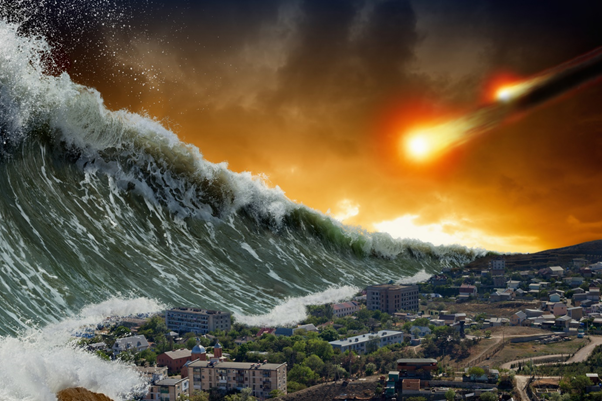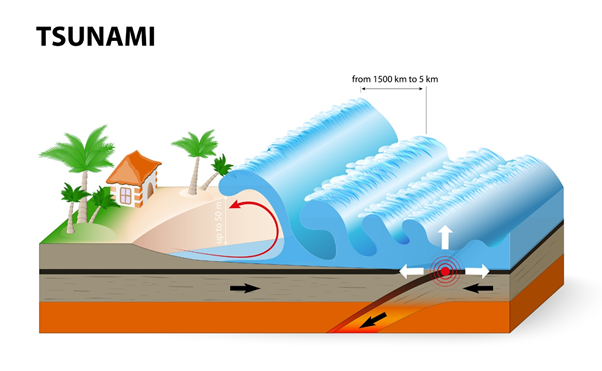What is a Tsunami?

Source: © Ig0rzh | Megapixl.com
Tsunamis are massive catastrophic waves caused by underwater volcanos and earthquakes. These waves travel in the outward direction from the source at speeds of up to 500 miles per hour. The speed of Tsunami waves is directly proportional to the depth of the ocean rather than the distance from the source location. Tsunamis can cause huge losses to life and infrastructure.
What are the causes of Tsunami?
Tsunamis are caused by underwater geological events that occur at the tectonic plate boundaries. There are three main causes of a Tsunami. Let us discuss them one by one.

Source: © Designua | Megapixl.com
- Earthquake: Underwater earthquakes cause most Tsunamis on the seafloor. When a tectonic plate interacts with another tectonic plate by passing aside or when a plate having higher density subducts under a different plate having lower density, overlying water displaces suddenly. The resulting waves start travelling in the outward direction from the place of origin.
- Landslide: Landslides can take place under the ocean, just like on lands. Steep and sediment-loaded areas at the edge of the continental slope are more vulnerable to landslides. During the event of an underwater landslide, a large mass of sediments moves in the downward direction under the effect of gravity. The movement of sediments displaces the water and generates tsunami waves that travel in the outward direction from the place of origin.
- Volcanic Eruption: Underwater volcanos are also one of the reasons for tsunamis; however, it is the most uncommon reason among all. Volcanos push the ocean water in the outward direction causing the tsunami waves.
How are Tsunamis different from regular waves?
Wind-generated waves arise due to the flow of air and cause water movement near the surface, whereas tsunamis involve the movement of water from the ocean floor to the surface. The speed of tsunamis is controlled by water depth, whereas wind-generated waves don't have any relation with the water depth. Wind-generated waves have a time difference of about 5 to 15 seconds between two crests, whereas a tsunami's period generally ranges from 5 to 60 minutes. The energy of a wind-generated wave breaks as they lose energy offshore, while tsunamis act like a flooding wave and their height is around 20 feet high.
What is the size of a tsunami?
The speed of tsunamis depends on the depth of water at which a tsunami got triggered. The velocity of a tsunami is equal to the square root of the water depth into gravity. The average speed of tsunamis is around 475mph at around 15,000 feet, whereas at 100 feet, the velocity drops to around 40mph.
The size of tsunamis ranges from mere inches to hundreds of feet. In deeper zones, the size of tsunamis is nearly a few feet, and its effects can't be noticed even in ships due to their longer period. However, the height of waves can increase over ten times. The height of tsunamis affects greatly along the coast, and the size gets amplified by the seafloor features.
Summary
- Tsunamis are massive catastrophic waves that travel in the outward direction from the original source at speeds of up to 500 miles per hour.
- Underwater earthquakes, landslides, and volcanic eruptions are some of the major reasons for tsunamis.
- The size of tsunamis is limited to few inches in deeper zones, whereas the size increases as waves reach the coast.
Frequently Asked Questions (FAQs)
Where do most of the tsunamis take place?
Most of the tsunamis occur in the Pacific Ocean because of a large number of earthquakes at the plate margin of the Pacific Ocean basin known as the "Ring of Fire". Around 90% of the world's total earthquakes take place along the Ring of Fire. A number of subduction zones are associated with the deep-sea trenches offshore of Indonesia, Japan, Alaska, and Chile. The region produced a number of earthquakes that triggered various tsunamis and devastated significant human lives in the Hawaiian Islands.
Where have the biggest tsunami disasters occurred?
A number of tsunami events took place in the past and caused significant loss to man and artificial infrastructure. In 2004, around 225,000 people in fourteen countries lost their lives due to the tsunami in the Indian Ocean. It was a powerful earthquake that was triggered near Sumatra islands that caused waves up to heights of 100 feet. The second most devastating event took place in the year 2011 in Japan due to the underwater earthquake on the country's eastern coast. The earthquake triggered waves of up to 133 feet in height and caused 15,000 deaths. The event also damaged Fukushima nuclear plant.
The third most devastating earthquake took place in 1964, with a 9.2 magnitude earthquake in Alaska. The event killed around 139 people, destroyed many buildings along the coastline and fired up oil storage tanks in the area.
What are the effects of tsunamis?
There are various devastating effects of tsunamis. Let us have a look at them one by one.
- Destruction: Most of the destruction is caused by two mechanisms - the first one is the destructive power due to the large volume of water, and the second one is due to the smashing force of the water wall. The weight of water destroys buildings and objects.
- Death: Tsunamis cause a large number of deaths. Thousands of people are killed by tsunamis. People living in the coastal areas don't have time to escape, and tsunamis' violent force causes instant deaths.
- Environmental Impacts: Tsunamis doesn't only destroy human lives but also cause damage to plants, animals, and other natural resources. Solid wastes and debris caused by the disaster caused critical environmental problems.
 Please wait processing your request...
Please wait processing your request...